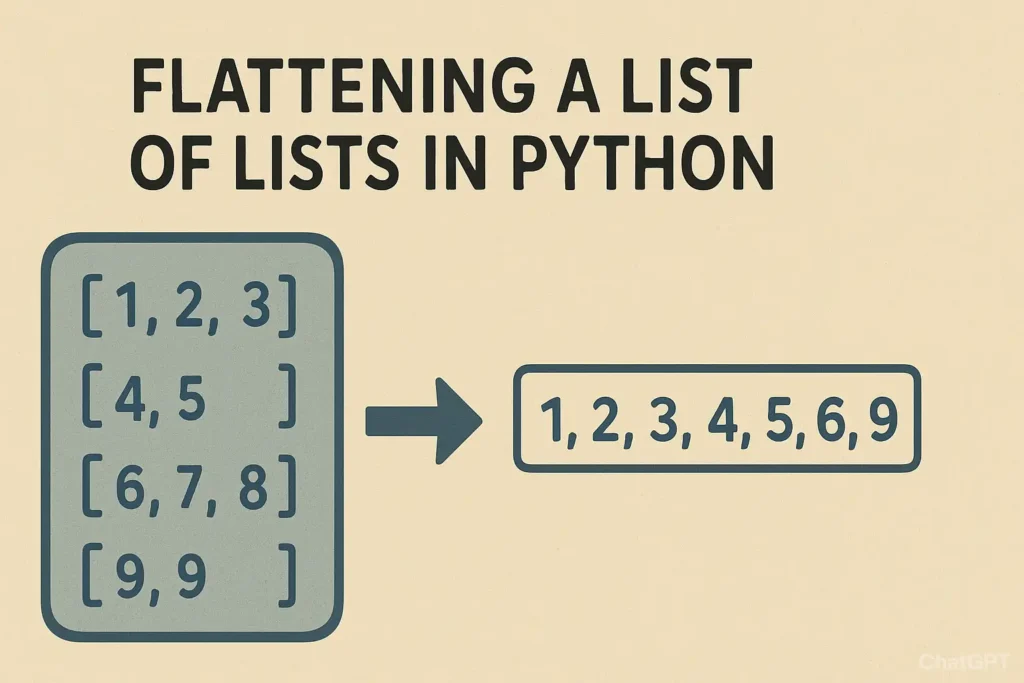You open one list, only to find another list inside, and then another. In programming, we call this a “list of lists.” While this is a powerful way to organize data, there are countless times when you just need a simple, single-level list to work with.
The process of converting this nested structure into a single list is called “flattening.”
Imagine you’re cleaning up a cluttered desk. You have several piles of papers (the lists of lists), and you need to put all the papers into a single, neat stack (the flat list) to feed through a scanner. That’s exactly what flattening a list does!
Example of a List of Lists:
list_of_lists = [[1, 2, 3], [4, 5], [6, 7, 8, 9]]Our goal is to turn this into:
flat_list = [1, 2, 3, 4, 5, 6, 7, 8, 9]Let’s explore the most effective ways to achieve this in Python, from the classic methods to the modern, elegant one-liners.
Method 1: The Classic For-Loop
This method is perfect for understanding what’s happening under the hood. We use a nested loop: one loop to go through each sub-list, and an inner loop to go through each item inside those sub-lists.
# Our nested data
list_of_lists = [['Alice', 'Bob'], ['Charlie', 'Diana'], ['Eve']]
# Start with an empty list to hold our results
flat_list = []
# Outer loop: iterate through each sub-list (e.g., ['Alice', 'Bob'])
for sublist in list_of_lists:
# Inner loop: iterate through each item in the current sub-list
for item in sublist:
# Append the item to our final flat_list
flat_list.append(item)
print(flat_list)
# Output: ['Alice', 'Bob', 'Charlie', 'Diana', 'Eve']Why use this method?
- Clarity: It’s very easy to read and understand, especially for those new to Python.
- Control: It gives you the most control. You could easily modify it to, for example, only add certain items that meet a condition.
Method 2: The itertools.chain()
The itertools.chain() function efficiently treats a series of lists as one continuous sequence, making it very fast.
import itertools
list_of_lists = [[10, 20], [30], [40, 50, 60]]
# The asterisk (*) unpacks the list_of_lists into separate arguments
flat_list = list(itertools.chain(*list_of_lists))
print(flat_list)
# Output: [10, 20, 30, 40, 50, 60]Why use this method?
- Speed: It’s highly optimized and one of the fastest ways to flatten a list, especially for large datasets.
- Memory Efficient: It works by creating an iterator, which doesn’t create intermediate lists in memory.
Method 3: List Comprehension
Developers love list comprehensions. They create lists in a single, expressive line, and many consider them the most ‘Pythonic’ way to flatten a list.
list_of_lists = [['Red', 'Blue'], ['Green'], ['Yellow', 'Purple', 'Orange']]
# Read it as: "For each sublist in list_of_lists, give me each item in that sublist."
flat_list = [item for sublist in list_of_lists for item in sublist]
print(flat_list)
# Output: ['Red', 'Blue', 'Green', 'Yellow', 'Purple', 'Orange']Why use this method?
- Concise: It gets the job done in one clean, readable line.
- Popularity: It’s the go-to method for most Python developers for everyday tasks.
A Real-World Example: Consolidating Weekly Tasks
Let’s say you’re building a simple to-do list application. Your data for the week might be stored as a list of daily task lists.
weekly_tasks = [
['Email client', 'Write report'], # Monday
['Team meeting', 'Buy groceries'], # Tuesday
['Gym', 'Read book'], # Wednesday
]
# You want a single list of all tasks for the week to calculate the total number.
all_tasks = [task for day in weekly_tasks for task in day]
print(f"Total tasks this week: {len(all_tasks)}")
print("All tasks:", all_tasks)
# Output:
# Total tasks this week: 6
# All tasks: ['Email client', 'Write report', 'Team meeting', 'Buy groceries', 'Gym', 'Read book']This flat list is now much easier to work with if you want to search for a specific task, count all tasks, or assign priorities across the entire week.
Deeply nested lists — recursive flattening
If your nesting depth is unknown (e.g., lists inside lists inside lists…), use a recursive approach. Be careful to treat strings as atomic (so they don’t get iterated character-by-character).
from collections.abc import Iterable
def flatten_deep(seq):
for item in seq:
if isinstance(item, Iterable) and not isinstance(item, (str, bytes)):
yield from flatten_deep(item)
else:
yield item
deeply_nested = [[[1, 2], [3, 4]], [[5, 6]], 7, ['eight', ['nine']]]
print(list(flatten_deep(deeply_nested)))
# [1, 2, 3, 4, 5, 6, 7, 'eight', 'nine']
Note: This handles arbitrary depths. If you only need to flatten one level, prefer the simpler methods above.
Summary: Which Method Should You Choose?
| Method | Pros | Cons | Best Use Case |
|---|---|---|---|
| For-loop | – Very clear and beginner-friendly – Easy to add custom logic (filters, transformations) | – Verbose – More lines of code | When you need readability or conditional flattening |
| List comprehension | – Concise & expressive – Considered the most “Pythonic” – Readable for experienced developers | – Harder to read with complex conditions – Can get messy in long one-liners | Everyday use for simple flattening |
itertools.chain.from_iterable() | – Very fast – Memory-efficient (iterator-based) – Scales well to large datasets | – Requires import – Less obvious for beginners | Large datasets or performance-critical tasks |
| Recursive function (deep flatten) | – Handles arbitrarily nested lists – Flexible (can adapt to skip/transform items) | – More complex to implement – Slightly slower than shallow methods – Recursion depth limit in Python |
For most situations, the list comprehension is the recommended choice. It’s a perfect but when it comes to multiple conditions, then use append because the code will become messy, you can’t figure it out later.
So next time you find yourself with a nested list, don’t unpack it manually, let Python do the heavy lifting and flatten it with ease
Comment below if you like or have any queries

